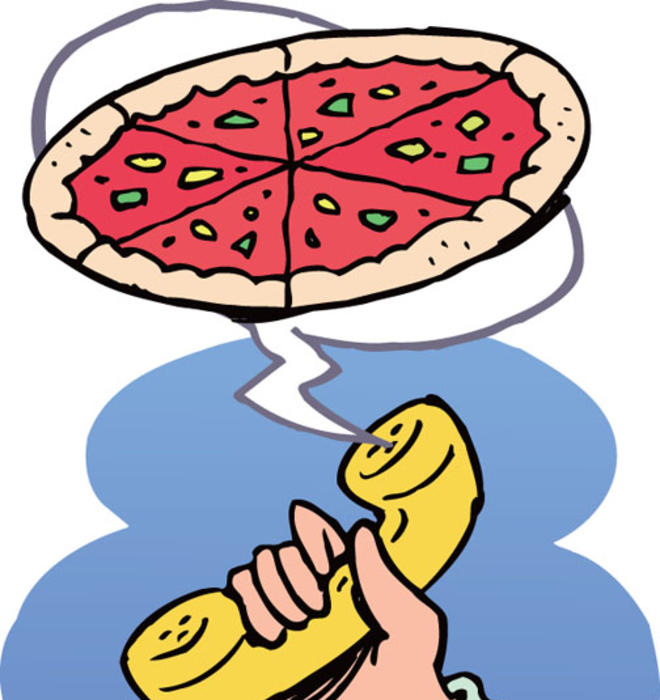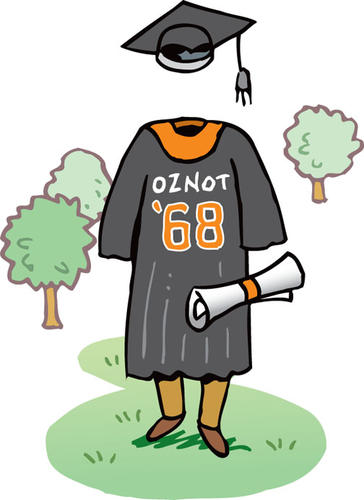
Take an environment that can generate the Triangle kickline, Cane Spree, and the Nude Olympics, let it percolate for 250 years or so, add a pile of 18-year-olds and The Daily Princetonian’s annual joke issue, and you would expect some pretty spiffy student pranks to break out.
You would be right.
From the discovery of the first 500-pound farm animal on the top floor of the first dorm, Nassau Hall, in 1756 – roughly 10 minutes after the first undergrads took up residence – students have approached with zeal and craft an array of jokes, hoaxes, and physical gags that beggar the mature imagination and often social propriety.
Here, counting down, are Princeton’s top 10 pranks – at least in this reviewer’s mind:
No. 10 When Harold Shapiro *64 returned to become Princeton’s president, his home phone number was listed in the local directory. So in 1996 an enterprising group of students printed hundreds of fliers advertising a new pizza joint on Nassau Street offering large cheese pizzas for only $5, and delivery until 2 a.m. – with Shapiro’s number. The telephone line at the new Hal’s Pizza was inundated by midnight, but the resourceful economist found the weak spot in the hoax: He took the phone off the hook.
No. 9 There was a point behind clapper stealing when it began in 1864: If the Nassau Hall bell didn’t ring, you didn’t have to go to class (or so students said). Freshmen nabbed the bell dozens of times over the decades, breaking inside locks, climbing outside walls, even masquerading as repairmen. But the expense to the University of computer-timing mechanisms, dramatic 40-foot student swan dives onto gravel and potentially — of course – lawyers doomed the quasi-annual tradition in 1992, when the clapper was removed permanently.
No. 8 On the theory that no altruistic gesture should go unpunished, final exams – unproctored, thanks to the Honor Code pledge, since 1893 – have proven a marvelous target of opportunity. Many are the examinees (unfailingly, ringers) who have burst into sobs and violent rants, ripped their papers to shreds, and stormed out. An inspiring exam-hall favorite in the ’60s and ’70s was the Red Baron, a dashing — literally – ace streaking through, to thunderous applause, in World War I pilot’s leather helmet and goggles, red silk scarf and/or red cape and/or red sneakers ... and nothing else.
No. 7 On the Thursday prior to the Yale football game in November 1979, four Yale cheerleaders picked up their mascot, Handsome Dan, for a photo shoot from the professor who owned him. They all then vanished. Not being complete sadists, the disguised Princeton undergrads who had pulled off the bulldognapping called the owner to reassure him and promise him wine and cigars, then returned Danny Girl – the only female Dan to date – to the real Yalies at halftime of the game at midfield, demurely festooned in orange and black.
No. 6 The Princeton University Band’s track record of friction with authority figures may have peaked with a November 1967 show at Harvard televised by ABC. The network was unhappy with the scramblers’ previously broadcast double entendres and was going to ignore the band; members got wind of this and invited the TV director to its Saturday-morning Cambridge rehearsal. The first formation was a gigantic “ABC” on the field with network theme music, while the public-address narrator intoned blandishments about “a blatant plug.” The director thought this was cute, so the network reversed course and carried the band show at halftime. On the field, though, the “A” quickly changed into an “N” and the band broke into “Who’s Sorry Now?”
No. 5 Awarding extra points for longevity, and for repeatedly appearing in front of both administrators and parents, we laudate the Latin salutatory address, a staple since 1748. Ostensibly a display of the students’ amazing facility in classical languages, around 1950 it took a huge leap into prankdom by surreptitiously giving only the new graduates Latin cue sheets telling them to applaud (hic plaudite), boo, hiss – whatever – at crucial points; thus it serves each class as a last bonding in-joke of us against the world. Stubbornly remaining in the original Latin as the rest of the Commencement ceremony switched over to English, it continues to this dei and ad infinitum.
No. 4 There have been many inspirational imaginary classmates, usually created to embody group spirit – among them, Scott Fitzgerald’s classmate Bert Hormone ’17 and Ephriam di Kahble ’39, who one term “turned in” 20 signed final exams (recall #8 above) – but the hands-down winner is Joseph D. Oznot ’68 p’01 s’01, created from thin air by four members of the Class of 1966 and so well-credentialed (great SATs and personal interview executed by non-Princeton ringers) that he was enthusiastically admitted by an oblivious admission office. His new Class of ’68 took the gag and ran with it, documenting Oznot’s daring global exploits in Class Notes over the years, including his relatively recent marriage to his daughter’s freshman roommate.
No. 3 Under pressure from veterans in 1936, Congress made controversial World War I bonuses payable immediately. In view of the grim world situation, an impromptu Princeton student group thereby demanded $1,000 payments in advance to all draft-eligible males since they certainly would be called into the military soon, and were at least alive to enjoy the money now. Gleefully anointing themselves as the Veterans of Future Wars, they struck a nerve in the national psyche; 500 campus chapters organized almost instantly, outraging both veterans and Congress.
No. 2 In 1875, acting on a rumor, Rutgers students stole the Revolutionary War cannon buried next to Clio Hall. It was returned from New Brunswick to Princeton only through the intercession of impartial negotiators, similar to today’s Middle East diplomacy. Subsequently, a week before the Rutgers-Princeton 100th-anniversary football game in 1969, it was stolen again, leaving behind a huge hole in the ground and derisive scarlet anti-Tiger graffiti. Several Rutgers groups took credit, and the proctors – based in Stanhope Hall, about 50 yards from the crater – were abashed. The day before the game, the Princetonian was tipped to the truth: Princeton seniors had dug the pit and piled the resulting dirt on top of the cannon, figuring correctly that no one would bother to look underneath. The cannon hoax embarrassed the bogus Rutgers claimants and raised Princeton school spirit, slightly salving the Tigers’ subsequent 29–0 loss.
And the No. 1 Princeton prank of all time: On the Friday afternoon of Houseparties in 1963, the desperadoes swung into action: A car was parked across the Dinky line, four horses rented from a nearby stable, masks and six-shooters acquired, “victims” prepared. The Great Train Robbery went off like clockwork, with four students riding out of a John Wayne film to hold up the blocked train on its way to campus, fire a couple blanks, “kidnap” four dates and then – after politely refusing the wallets and gold jewelry offered by clueless commuters – galloping into the woods, the eight men and women hanging onto the horses for dear life. The conductor arrived at Princeton station with the honor of being the victim of the only railway holdup in the United States since 1923; the perps rode over to Cap and Gown in full regalia, stopping by Bo Diddley’s live set on the front lawn. Thence they rode west, into the sunset and the mists of legend.
It’s certainly true that a successful prank is dependent upon timing, the prankster, the prankee, and good publicity — not to mention the local forces of law and order — so this list is necessarily subjective. If you feel your roommate’s adventure with the dry ice, wastebasket, and two hamsters should have made the top 10, don’t just seethe. Rush to paw.princeton.edu with your story, or any other campus-prank tale you’ve heard, and share it by posting a comment to this article. It’s also a good place to check on prank/hoax rumors you may have long puzzled over; arguments will be adjudicated by Liz Greenberg ’02, author of the senior thesis “Barely Remembered: A History of Princeton University Prank Traditions,” using the strictest of standards:“What would the Red Baron do?”
Gregg Lange ’70, PAW Online’s Rally ’Round the Cannon columnist, last May received the Alumni Council Award for Service to Princeton. Presumably, this was not a hoax.















11 Responses
Harrison Bregman ’92
9 Years AgoMore tales of pranks
Thought you all might like to know that my mother, Susan Louise Wolfe Harrison, Class of ’64 at Smith College, was one of the four women who were “kidnapped” from the Dinky via horse in the No. 1 prank from the PAW list (features, Jan. 19). She died in December 2009, but remembered that day with glee! Interestingly, she married a Tiger, Robert Harrison ’61, but he obviously was not one of the kidnappers as he had already graduated. They met later in Houston, Texas.
Fred Geldon ’68
9 Years AgoMaking a bold statement
I don’t know whether this qualifies as a prank, but just before Reunions in 1968 my roommates and I hung a sheet from the then-unfinished Fine math tower. In the sheet we had written “COEDUCATION NOW!” in big red letters. There were no working elevators, so to do this we had to climb all 13 stories of stairs, exposed to the elements.
The banner faced the campus throughout Reunions. It’s my fantasy that it had something to do with the decision during the following year to implement coeducation.
James Machin ’71
9 Years AgoMore on a band prank
Your “Funny Princeton” issue was very entertaining, especially the Top 10 pranks. I can relate well to No. 6, which described the Princeton University Band (“PUB,” as we called ourselves) on nationwide TV (ABC network) at Harvard forming ABC on the field, then changing to NBC at the last second, as I was a freshman in the band at that time and was on the field.
And now for The Rest of the Story. When the “A” changed to “N,” we first played the NBC “gong” sound, then went into “Who’s Sorry Now.” The cameras had zoomed in on ABC, and when it changed with the gong, the announcer got flustered and started saying something like, “Uh, the band is apparently saluting the networks.” But when the on-site ABC producer saw it, he reportedly “went up the wall!” When this report was related to the band the next week in rehearsal, you can only imagine the hilarity that ensued. If I wasn’t already cemented in the band and the fun we had, I certainly was after that. Fond memories of an organization I was proud to be a part of. I still have my PUB Ivy Champs T-shirt we made for ourselves.
Joe Fox ’44
9 Years AgoDon't look up
This is a pretty simple prank: It involves my classmate, Professor Marius Jansen ’44, a very respected member of the Princeton faculty for many years.
We both roomed in Dod Hall freshman year, and Marius’ room was directly over the main entry. Marius taught me how to fold a sheet of paper back and forth many times, creasing it, folding it, and tucking in the edges to form a hollow cube, which could be filled with water.
He had the brilliant idea, then, of dropping these water bombs in front of people entering the building. Of course, we were both extremely careful not to hit anyone unless it was a good friend.
Robert E. “Bob” Buntrock *67
9 Years AgoFun with the fountain
As a chemistry Ph.D. candidate (entering in 1962), I was taking a qualifying exam in the southeast corner of Frick Lab the day they moved the Woodrow Wilson School building back 100 yards to make room for the new Yamasaki-designed building for public affairs. The clanging of shim removal from the rails accompanied our entire exam.
Eventually, in front of the new building (the design was condemned since it seemed to be a carbon copy of other Yamasaki buildings, including the Federal Reserve building in Minneapolis), a magnificent pool and fountain were built. The fountain superstructure was a large, naturally rusted abstract metal sculpture. It didn’t take long for the pranksters to strike.
Occurring during Reunions weekends, two pranks come to mind from the mid-60s. One morning, the water was a brilliant purple, the color reminiscent of potassium permanganate (after all, it was next door to the chemistry building). Another time, a fair amount of detergent was poured in overnight, turning the pool into a massive bed of foam. The fountain was turned off, but the “damage” already had been done. Hoses were brought out in an attempt to rinse the foam down the drains. The force of the hoses tore off chunks of the sudsy foam, wafted into the air by the freshening breeze.
Robert E. “Bob” Buntrock *67
9 Years AgoWrong building
Thanks for publishing my April 6 letter re pranks involving the Woodrow Wilson Plaza fountain. I described the “new” building on the plaza as Yamasaki-designed, deemed by many to be a clone of the Federal Reserve building in Minneapolis.
I received a postcard from Jim McAfee ’66 taking me to task. He said the only Yamasaki-designed Federal Reserve building was in Richmond, and that it didn’t resemble the WWS building. I recently examined a map of downtown Minneapolis (my hometown) and determined that the ING Reliastar building was designed by Yamasaki.
Regardless, I do recall the controversy in the Princeton community that the University got a “copy.”
Frank Jackson ’55
9 Years AgoRecounting the horse's tale
Just got the Jan. 19 issue on humor. Well done, except that you did not list the horse that appeared on the third floor of our Rockefeller suite on a Houseparties weekend. (The year was 1954, I believe.) The horse belonged to a trustee, and there was obviously a good deal of alcohol associated with the incident. However, the incident did not humor the trustee one bit. A bit of a toad, we all thought.
Tom Parr ’55
9 Years AgoHorse prank was risky
While at first blush the horse incident described by my classmate Frank Jackson ’55 (letters, March 23) might sound humorous, it could have been fatal to the owner and/or the horse. The horse was an oversized thoroughbred given to its owner, Donald Griffin ’23, by famed Greentree Stable trainer Mose Gaver ’24, his Princeton roommate. Due to his size, the horse was not suitable for racing. After the fact, I examined the scene of the crime, and it was hard to imagine how the horse, named Says Who, was able to stand on the landing to which he had been led, much less negotiate the narrow stairs. Through Mr. Griffin’s kindness, I had been allowed to exercise the horse freshman year and knew him well.
Due to the narrow, steep, and slippery (metal-edged) nature of the stairs, Says Who easily could have fallen on his owner, who led him down the three flights at the risk of his own life. Mr. Griffin was the University’s Alumni Council secretary for many years, not a trustee, and had played center on Princeton’s famous Team of Destiny. He was the furthest thing from “a bit of a toad.” His son, Jim Griffin ’55, is our distinguished classmate.
In my opinion, pranks involving animals reveal cluelessness and low self-esteem on the part of the perpetrators. I guess that’s why they called us “college boys.”
Robert E. “Bob” Buntrock *67
9 Years AgoThose 'Prince' spoofs
I was at Princeton from 1962–67, earning a Ph.D. in chemistry. I remember well The Great Train Robbery, at least from the coverage in The Daily Princetonian and elsewhere. What was not mentioned was that the perps could have faced legal punishment, since that was the one Dinky of the day that was a mail train, making their prank potentially a federal offense. It was reported that one of them had a relative in high places who secured suspension of any legal action for their daring raid, since it was a prank and not a “robbery.”
I also remember the hilarious spoofs in the end-of-semester editions of The Daily Princetonian. One memorable “article” claimed that Bill Bradley ’65, tired of being called a “Weeny Wonk” by Cosmo Iacavazzi ’65 *68, said he was quitting basketball to try out for the football team. The football coach celebrated widely and said he’d play Bradley at longside end and was ecstatic. Fun days.
Robert M. Ellsworth ’82
9 Years AgoMore Tiger pranks
My favorite “concept” prank (feature, Jan. 19) was swapping whole floors of offices in Fine Tower. Each floor in this tower is almost exactly like the others, except for the view out the windows. Sufficiently far from the ground, they’re interchangeable, except for the usual sorts of “personalization” on the various doors.
What could be more natural, then, than swapping two floors’ worth of door numbers and decorations, with a few quick adjustments to the elevator machinery ... and, as it turned out, I could go right down to the University’s facilities building, pull the University blueprints for the elevators and their control wiring, have the blueprints duplicated for me at University expense, and then have the University staff re-file them for me. Then just a few measurements and the cutting of a few extensions for the wires, and the stage was set ...
Unfortunately, I came down with a migraine headache when the time for performing the caper approached, and the folks actually doing the “work” decided for some reason just to cut and splice the wires. The prank was not so funny when the contractor who had to repair the kludge charged the University something like $750 to reconnect things to code.
Stuart Hibben ’48
9 Years AgoWhen toilet paper exploded
I confess that I was complicit in a freshman-year prank that involved the infamous Toilet Paper Bomb: Take a roll of toilet paper, plug up one end, pour in powdered explosive, plug up the other end, and bore a hole for a twisted-paper fuse — and voilà, you had a device that would explode with a deafening boom but only spray paper fragments, making it (relatively) harmless.
The evil genius behind this was classmate Jim O’Neill, who devised the formula for the explosive, which was basically gunpowder. We pulled this off several times in Holder Court late at night with gratifying success: a thunderous report, followed by hordes of angry students milling about and proctors running in from all directions.
The final episode was a near-disaster. We had just lit the fuse when a proctor appeared. Jim quickly snuffed out the burning fuse, grabbed the bomb, and we ran into the nearest dorm entry. When the proctor had left, we decided to launch the bomb. But there wasn’t much fuse left, and Jim barely had time to toss the bomb when it exploded.
We scattered in a panic, knowing the proctors would show up. I barged into a dorm room and begged the resident to let me hide. I barely had time to wriggle under the bed when a proctor burst in and asked if anybody had come in, which the student denied. Still, the proctor took a look in the bedroom; I watched his shoes pass inches from my face. The hair on Jim’s arms and eyebrows had been singed off, so we decided that we would do no more bombs. If that student had ratted me out, I’d have been on the next train home.